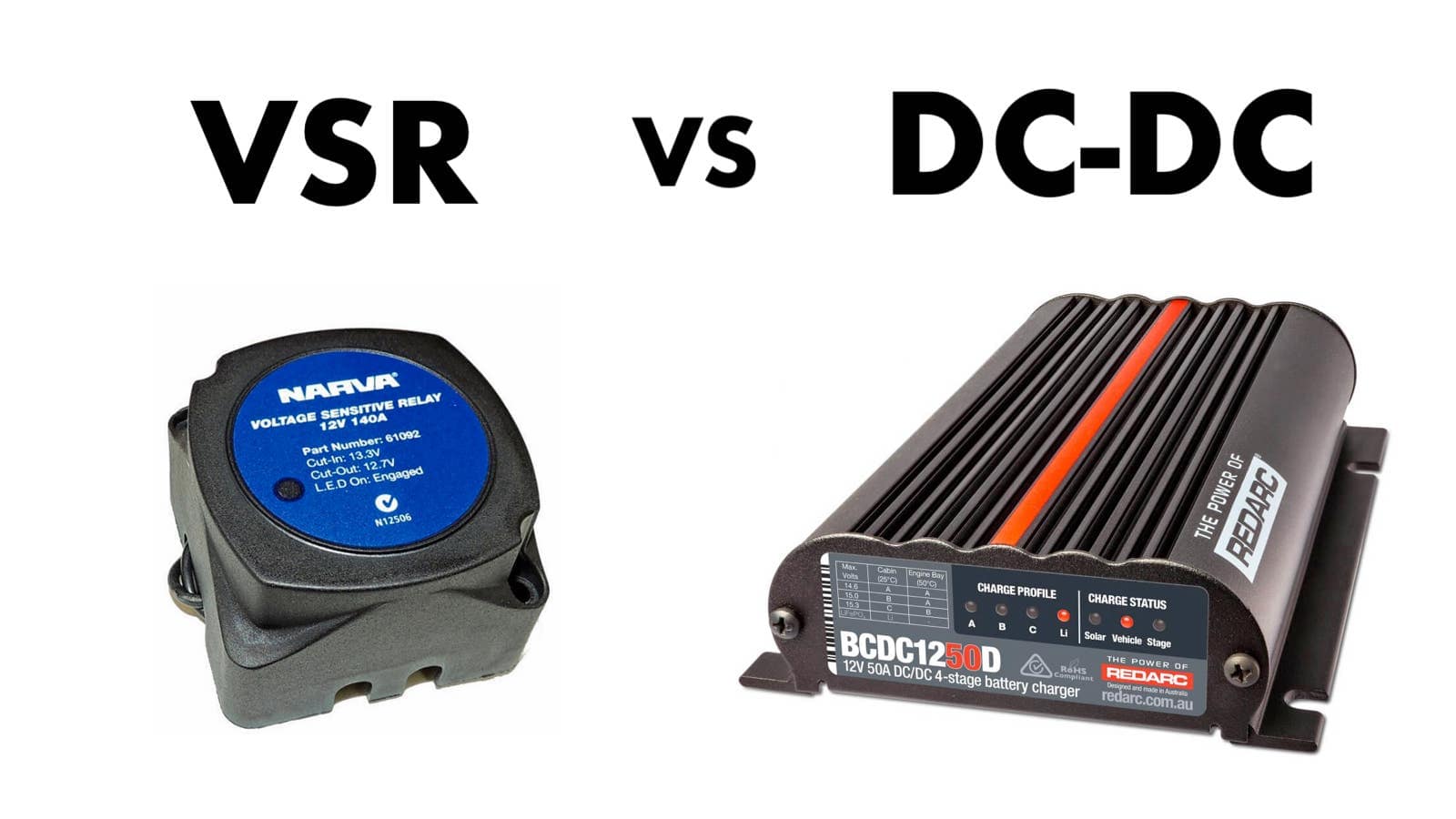In building our 4x4 adventure vehicle system, I learned a lot about the way people build dual battery systems in cars and trucks.
You build a dual-battery system into a car or truck for mainly one reason: to keep your accessories (fridge, chargers, epic sound system) on one battery, and your vehicle system (starting and operating critical electrics) on the other.
There are three main ways you can connect two (or more) batteries in a dual- or multi-battery system
- Direct parallel connection. This works, but is the worst solution.
- Voltage Sensitive Relay/Isolator (a.k.a. "VSR"). This works better, and isn't very expensive.
- DC-DC charger. These are expensive but have multiple benefits.
Let's go through the pros and cons of these in turn.
Dual Battery Systems — Direct Connections
- Cheapest
- Engine bay only, lead acid batteries only
- Gets 80% out of your accessory battery; doesn't charge it too fast
- May leave you stranded
- Won't work with latest cars with smart alternators
It's tempting to think "Ah, I'll just connect the batteries in parallel!"
This works, but only with a precarious set of assumptions:
- The batteries have the same capacity and chemistry. If not, then you may not charge one to its fullest level.
- The voltage that arrives at each battery is the same. A short distance difference of just one metre usually results in a few tenths of a volt difference with the current that we normally see in 12V systems.
- Batteries are at the same condition level. They usually aren't.
This means that if you connect two batteries in parallel, you'll never get full potential out of your system.
Secondly, if you connect two in parallel, you lose out on the two main benefits of dual battery systems:
- You won't drain your starter battery. If you have another battery to power your current-hungry accessories, you'll be able to run your battery flat and still be able to drive home.
- You can (maybe) use your second battery to start the car. If your starter battery fails, you can perhaps use current from your accessories battery to either start the car, or to charge your cranking battery.
So a dual battery system in parallel will work and won't cause any huge problems, but it doesn't cost much to go to the next best solution: a VSR.
Dual Battery Systems with a VSR (Voltage Sensitive Relay)
- Engine bay only, lead acid batteries only
- Prevents you from draining starter battery
- Gets 80% out of your accessory battery; doesn't charge it too fast
- Cheapish ($50-150, plus wiring etc.)
- Won't work with latest cars (~2015 onwards) with smart alternators
The next best dual-battery system is one with a VSR. This is suitable for under-bonnet set-ups where cables are short and batteries are the same kind.
A VSR is a high-current relay that has simpler wiring than most relays.
A relay (for those who don't know) is a switch that's triggered by voltage. In cars and motorcycles, you use a relay on something like the accessories wire (that's only live when the bike is on) to power other high-current accessories, like extra lights, a fridge, or heated grips. This lets you run those accessories without drawing too much current through a single wire.
A VSR is a relay that separates the car's main cranking battery and the secondary accessories battery. The VSR is triggered by detecting when the alternator is running and charging the car battery. When the VSR detects that the car is on, it says "Hey the car's on! OK let's connect the two batteries". Thus, your secondary battery starts charging.

The advantages of a VSR are that you get the potential full advantages of a dual battery system mentioned above, namely, that a) if the car is off and you're powering accessories, you won't drain your cranking battery, and b) if you need (in a pinch) to use your secondary battery to crank the car, you can override with the click of a switch.
The disadvantages of a VSR are that you'll never fully charge your accesories battery, and thus never get full use out of it.
Why is that? Well, it varies by car. But it's for the following reasons:
- Cars don't try to optimise to keep the cranking battery at 100%; you'll only get about 80% out of it. They simply don't need to, so why should they? A cranking battery will last longer if it's not fully charged, and there's no way you need all the stored power to start the car. So they won't do the same for another battery, either. Firstly, a basic alternator + regulator/rectifier doesn't optimise for stages of charging of a battery (you have to charge them at a different rate as they get more full). Secondly, they don't even try. So you'll only get about 80% out of your secondary battery.
- Modern cars (~2015 onward) have "smart alternators". Smart alternators may detect that the cranking battery is at 100% and then turn off the charging system, even if the accessory battery is at less than 100%, and so may never charge the secondary battery.
- If there is voltage drop between the cranking battery and the second battery (if there is any distance between them, or a thinner gauge cable), then the secondary battery won't be fully charged.
But a VSR works in a simple situation where you have two batteries under the bonnet and you want to provide a degree of protection of the cranking battery from being drained. It actually will work for most people, despite the above limitations.
The main downsides of a VSR are that
- It won't charge the secondary battery as efficiently, or fully, as mentioned above.
- Your battery pretty much has to be a heavy one, under the bonnet. This means a) ~30kg of extra weight (vs a lithium), and b) you can't use lithium with this systme.
- You need a separate solar controller. DC-DC chargers often come with high-tech in-built solar controllers (much better ones than the solar panels ship with), which saves you from doubling up on purchases.
DC-DC chargers — the Gold Standard
- More expensive — $250+, $400+ for a good one
- Get 100% out of your battery, and charge it faster
- Lets you use lithium, keeping the battery outside the engine bay
- Better for solar (with a better DC-DC charger)
A DC-DC charger takes DC from one source (usually the alternator/existing battery, or a solar panel), optimises it to charge a battery depending it on its type, condition, and level of charge, and then outputs DC to charge the battery.

DC-DC chargers are what you need if you
- Want to use a lithium battery (saving weight, and increasing usable charge), or another battery kind. Charging a lithium battery means applying different voltage in different stages to a lead acid battery.
- Want to charge the battery faster, and/or get 100% out of it (rather than 80%). DC-DC chargers have multi-stage charging.
- Want to keep the battery outside the engine bay in your canopy, trailer, caravan, or camper. You place a DC-DC charger near the battery, and it doesn't matter if there's voltage drop before then — it takes care of it.
- Use a solar panel as an alternative charger. Most solar panels come with PWM regulators, but these leave about 20-25% of potential power output on the table, and you need an MPPT regulator anyway. A good DC-DC charger comes with one built in.
There are cheaper DC-DC chargers from vendors like Jaycar and Adventure Kings that don't have an MPPT solar regulator in them. These lack what I think is one of the best advantages of a DC-DC charger input. If you get one of them, you're not saving money, because you'll need to buy an MPPT regulator anyway.
The best ones that do have an MPPT regulator are from
- Redarc
- Intervolt
- Kickass (a cheap distributor, but their products aren't bad)
Generally people seem to love Redarc — there aren't reports of them failing after a few months to a year of use.

